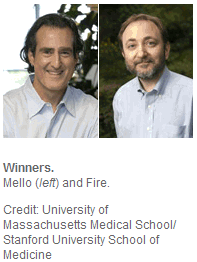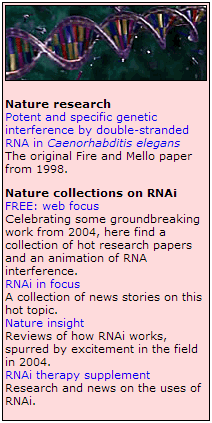 Nobel
Prize in Medicine or Physiology Goes to Discoveries in Mechanisms of
Interference RNA. (October 3, 2006)
Nobel
Prize in Medicine or Physiology Goes to Discoveries in Mechanisms of
Interference RNA. (October 3, 2006)
|
|
|
|
|
|
|
News & Views item - October 2006 |
![]()
 Nobel
Prize in Medicine or Physiology Goes to Discoveries in Mechanisms of
Interference RNA. (October 3, 2006)
Nobel
Prize in Medicine or Physiology Goes to Discoveries in Mechanisms of
Interference RNA. (October 3, 2006)
Craig Mello of the University of Massachusetts Medical School and Andrew Fire of Stanford University have been awarded the A$1.9 million Nobel Prize for Medicine or Physiology, ending speculation in the field of RNA interference (RNAi) about who would get the Guernsey.
The two Americans were singled out from a number of worthy contenders for their discovery in 1998 of one of the fundamental mechanisms by which gene expression is controlled.
RNAi, occurs naturally in plants and animals,
and is a mechanism whereby gene activity can be shutdown thereby regulating gene
expression. Among other uses it protects against certain viral infections and controls so-called 'jumping
genes' that can replicate and spread through the genome.
protects against certain viral infections and controls so-called 'jumping
genes' that can replicate and spread through the genome.
Fire and Mello were investigating steps in the process by which the information encoded in genes winds up in the manufacture of specific proteins. They were interested to see whether they could influence the production of muscle protein in the worm Caenorhabditis elegans by tinkering with the messenger RNA transcribed from the relevant gene. After running up a number of blind alleys they found that when they injected double-stranded RNA made up of both sense and antisense RNA sequences bound together, the worms displayed twitching behaviour similar to that of genetic mutants with no muscle gene at all. They had silenced the gene.
They went on to unravel the mechanism by which the gene interference works, and the reason why simply injecting antisense RNA doesn't silence genes.
As Michael Hopkin in news@nature.com writes:
Double-stranded RNA is recognized by a protein called Dicer, which breaks it up into tiny double-stranded fragments. These fragments are then bound by a protein complex, RISC, which strips away one of the strands, leaving a complex bearing a tiny strip of RNA. (Although this process results in single strands, starting with a single strand of RNA does not have the same effect as it activates neither Dicer nor RISC).
The resulting complex binds to naturally produced mRNA, cutting it into strips and destroying it, silencing its parent gene.
Nobel Laureate Phillip Sharp of the Massachusetts Institute of Technology in Cambridge referring to the 1998 paper in Nature describing Fire and Mello's findings said, "The avalanche [in RNAi research] was started down the hill by this paper."
Nick Hastie, director of the Medical Research Council Human Genetics Unit in Edinburgh, UK said simply, "They opened up a whole new area of biology, which was unsuspected before. It is also one of the quickest recognitions of a discovery. To find this in 1998 and get a Nobel Prize in 2006 is remarkable."
RNAi is used increasingly as a research tool and there
is keen interest in possible clinical uses, but a note of caution has been
sounded about the potential dangers of
RNAi -- one recent trial, for example, showed that its use could prove fatal to
mice